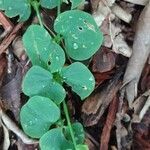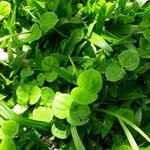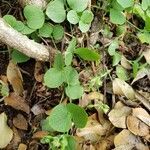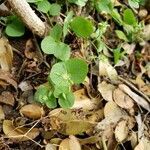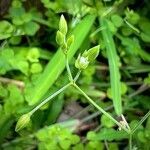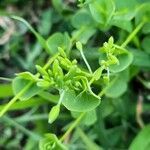Tender herb with stems straggling, procumbent or ascending, branching dichotomously, often rooting at the lower nodes, quadrangular, glabrous or papillose (especially above); leaves rather widely spaced. Leaves on glabrous petioles up to 1 cm long; lamina 1-3.5 x 0.6-3.0 cm, ovate to very broadly ovate, apex acute or subacute and shortly apiculate or occasionally rounded or obtuse, cordate, truncate or abruptly cuneate at the base, 3-7-nerved at the base, glabrous; stipules c. 1 mm long, interpetiolar, deeply fringed or composed of several subulate segments. Flowers in axillary or terminal, rather loose dichotomous cymes 2-25 cm long, peduncles slender and often elongate; bracts 1-4 mm long, narrowly lancolate, membranous; pedicels 1.5-5(12) mm long, filiform, glabrous or papillose. Sepals green with whitish margins, narrowly lanceolate, acute, keel viscid-papillose, with an additional nerve on each side of the midrib. Petals white, deeply bilobed, somewhat shorter than the sepals, sometimes absent. Stamens 5 or reduced to 3; filaments c. 2 mm long; anthers c. 0.5 x 0.4 mm Ovary ovoid-ellipsoid, usually 3-ovulate; style c. 0.25 mm long with 3 spreading stigmatic arms. Capsule c. 2 x 1.5 mm ellipsoid. Seeds 1-3, c. 1 x 0.75 mm, somewhat flattened-reniform; testa brown, minutely and bluntly tubercled.
A straggling herb with procumbent and more or less ascending branched stems, often rooting at the lower nodes, quadrangular, glabrous or papillose especially in the upper internodes; internodes slender, generally 2–6 cm. long.. Leaves opposite, blades ovate to very broadly ovate, acute or subacute and shortly apiculate or even rounded at apex, cordate, truncate, or shortly cuneate at base, 1 cm. long and 0.6 cm. broad up to 3.5 cm. long and 3.0 cm. broad, 3–7-palminerved, glabrous; petioles 2–7 mm. long; stipules inter-petiolar, about 1 mm. long, deeply fringed or composed of a number of subulate segments.. Cymes terminal or axillary, often loose on long slender peduncles and with slender branches; pedicels at anthesis mostly 3–5 mm. long.. Sepals narrowly lanceolate, acute, 3.5–5 mm. long, keeled along the papillose midrib, with one nerve on each side; the flowers (presumably the sepals) are said to be sticky.. Petals 3 mm. long, white.. Ovules usually about 3.. Seeds 1.5 mm. in greatest diameter, bluntly tubercled.. Fig. 4.
Annual herb to 45 cm long, erect to prostrate; stems branched, angled, often rooting at nodes, glabrous to densely glandular-puberulent. Petiole filiform, 2-15 mm long; stipules membranous, multilacerate, to 2 mm long; blade orbicular, ovate-orbicular or reniform, 5-25 x 5-30 mm, obtuse or acute and mucronulate at apex, round to cordate at base, glabrous or puberulent. Inflorescences terminal or axillary, few-flowered dichasial cymes, lax; pedicels 2-15 mm long, densely stipitate-glandular puberulent. Sepals 5, ovate, oblong-lanceolate or lanceolate, 2.5-3.5 mm long, glabrous except for stipitate-glandular puberulent midvein; petals 5, white, deeply clawed and bifid, shorter than calyx, 2-3 mm long, lobes linear; stamens 2-3(-5), filaments ca. 2 mm long; ovary ovoid, styles 3, 0.5-1 mm long. Capsule ovoid, slightly shorter than calyx, 1.5-2.5 mm long, shortly pedicellate; seeds 1-12, cochleate, 1.0-1.5 mm long, dark reddish-brown or black, densely tuberculate in lines.
Herbs, annual with fibrous roots, often adventitious from nodes, glabrous to densely pubescent, glandular or eglandular. Stems prostrate to ascending, to 30 (–60) cm long. Leaves petiolate, opposite or pseudoverticillate; petioles 2–15 mm long; lamina broadly ovate to reniform, obtuse, occasionally mucronate, 5–25 mm long, 5–30 mm wide; stipules lacerate to base, often in two layers, to 2 mm long. Inflorescence of branching, cymose panicles; bracts with broad, scarious margins, 1–5 mm long. Flowers 4–5 mm diam.; pedicels evenly glandular-puberulent, 1–8 mm long. Calyx ± glabrous. Sepals 2–4.5 mm long, thin to robust, prominently 1–3 (–7)-ribbed, ± carinate. Petals 5, 1.5–3 mm long, white, deeply bifid; lobes linear, acute to obtuse. Styles 3. Capsule 1.5–2.5 mm long, ovoid, 3-valved. Seeds 1–several, 0.8–2 mm wide, reddish brown, tuberculate.
Plants annual. Stems straggling, sometimes subscandent, usually rooting at lower nodes, 60--90 cm, mostly glabrous, minutely papillose toward inflorescence. Stipules membranous, splitting into few whitish setae. Petiole poorly defined, 3--7 mm; leaf blade ovate-cordate, (0.5--)1--3(--3.5) × 0.6--3 cm, prominently 3--5-veined from base. Bracts lanceolate, scarious. Pedicel 3--5 mm, slender, glandular hairy. Sepals lanceolate-ovate, 2--3.5(--5) mm, margin membranous, 3-veined, glandular hairy, apex subacute. Petals white, obovate-cuneate, ca. 2.5 mm, deeply 2-cleft; segments narrow, apex ± acute. Stamens 2--3(--5), shorter than sepals. Styles 3, connate at base. Capsule ovoid, (1.5--)2--3 mm in diam., 3-valved. Seed dark brown, suborbicular, ca. 1.5 mm, regularly densely tuberculate. Fl. Apr--Oct, fr. Jun--Dec.
Annual herb, 0.25-1.50 m high; procumbent or ascending, branching dichotomously, quadrangular, glabrous or papillose. Leaves petiolate, stipulate, glabrous, ovate to broadly ovate, rather widely spaced. Inflorescences axillary or terminal dichotomous cymes; flowers pedicellate. Sepals green with white margins, narrowly lanceolate, acute, keel viscid-papillose. Petals white, deeply bilobed, shorter than sepals, sometimes absent. Stamens 3-5. Ovary ovoid-ellipsoid. Flowering time Aug.-Apr. Fruit a capsule, ellipsoid. Seeds flattened-reniform, testa brown, minutely or bluntly tubercled.
An annual herb. It climbs or creeps along the ground. It has branches that divide in two. It often forms a dense ground cover. The stems form roots at the nodes. The leaves are small, opposite and heart shaped. The leaves are 0.8-2 cm long by 0.5-2 cm wide. The flowers are small and white. The are in twice branched heads at the ends of the stems. The fruit is a capsule. It splits to release small seeds.
Leaves on glabrous petioles up to 1 cm. long; lamina 1–3·5 × 0·6–3·0 cm., ovate to very broadly ovate, apex acute or subacute and shortly apiculate or occasionally rounded or obtuse, cordate, truncate or abruptly cuneate at the base, 3–7-nerved at the base, glabrous; stipules c. 1 mm. long, interpetiolar, deeply fringed or composed of several subulate segments.
Flowers in axillary or terminal, rather loose dichotomous cymes 2–25 cm. long, peduncles slender and often elongate; bracts 1–4 mm. long, narrowly lancolate, membranous; pedicels 1·5–5 (12) mm. long, filiform, glabrous or papillose.
Tender herb with stems straggling, procumbent or ascending, branching dichotomously, often rooting at the lower nodes, quadrangular, glabrous or papillose (especially above); leaves rather widely spaced.
Sepals green with whitish margins, narrowly lanceolate, acute, keel viscid-papillose, with an additional nerve on each side of the midrib.
Seeds 1–3, c. 1 × 0·75 mm., somewhat flattened-reniform; testa brown, minutely and bluntly tubercled.
Ovary ovoid-ellipsoid, usually 3-ovulate; style c. 0·25 mm. long with 3 spreading stigmatic arms.
Petals white, deeply bilobed, somewhat shorter than the sepals, sometimes absent.
Stamens 5 or reduced to 3; filaments c. 2 mm. long; anthers c. 0·5 × 0·4 mm.
Capsule c. 2 × 1·5 mm. ellipsoid.
